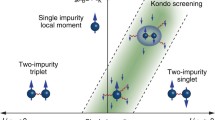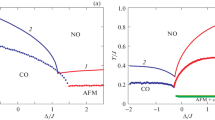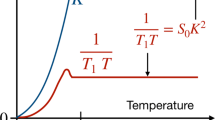Abstract
Recent experiments on the low-temperature magnetic susceptibility χ of very dilute concentrations of iron impurities in copper show a significant contribution proportional to the square of the iron impurity concentrationc. The two explanations that have been proposed for thisc 2 dependence are: (a) a qualitative explanation in which thec 2 term in χ arises from the “clustering” of pairs of Fe impurities in the Cu-Fe system; (b) a model in which thec 2 dependence arises from the suppression of the spin-compensated state by the many-impurity interaction. In order to study mechanism (b) further, we obtain the magnetic susceptibility for a two-component Kondo system having different Kondo temperatures. We find that thec 2-dependent contributions to χ for the two-component system will be qualitatively different for explanations (a) and (b). We propose an experiment which could possibly distinguish between them. We also find that the suppression of the Kondo temperature by the impurity-impurity interaction yields an effective Kondo temperatureT EK which is concentration-dependent. Thus there may be a large discrepancy between the effective concentration-dependent Kondo temperatureT K (c) obtained from the magnetic susceptibility χ ∝ [T+T K (c)]−1 andT K, the Kondo temperature at infinity dilution. Our results indicate that for Cu-Mn one would have to go to a dilution of less than 1 ppm in order forT K (c) to approachT K in the expression for the magnetic susceptibility.
Similar content being viewed by others
References
J. Kondo, inSolid State Physics, Advances in Research and Application, Vol. 23, F. Seitz, D. Turnbull, and H. Ehrenreich, eds. (Academic Press, New York, 1969).
A. J. Heeger, inSolid State Physics, Advances in Research and Development, Vol. 23, F. Seitz, D. Turnbull, and H. Ehrenreich, eds. (Academic Press, New York, 1969).
J. L. Tholence and R. Tournier,Phys. Rev. Lett. 25, 867 (1970).
H. E. Ekstrom and H. P. Myers,Phys. Kondens. Materie 14, 265 (1974).
M. W. Klein, L. Shen, and Y. C. Tsay,J. Low Temp. Phys. 19(5/6), 433 (1975).
E. C. Hirschkoff, M. R. Shanaberger, O. G. Symco, and J. C. Wheatley,L. Low Temp. Phys. 5, 545 (1971).
J. C. Hirschkoff, O. G. Symco, and J. C. Wheatley,J. Low Temp. Phys. 5, 155 (1971).
Y. C. Tsay and M. W. Klein,Phys. Rev. B 7, 352 (1973).
Y. C. Tsay and M. W. Klein,Phys. Rev. B 11, 318 (1975).
Y. Nagaoka,Phys. Rev. 138, A1112 (1965);Progr. Theor. Phys. (Kyoto)37, 13 (1967).
D. K. Schotte and U. Schotte,Phys. Rev. B 4, 2228 (1971).
K. G. Wilson, Cornell University Preprint.
A. I. Larkin, V. I. Mel'nikov, and D. E. Khmel'nitzky,Soc. Phys.—JETP 33, 458 (1971).
H. Margenau,Phys. Rev. 48, 755 (1935).
M. W. Klein,Phys. Rev. 173, 553 (1968).
I. S. Gradshtein and I. M. Ryshik,Table of Integrals, Series, and Products (Academic Press, New York, 1966), p. 500.
W. P. Pratt, R. I. Shermer, and W. A. Steyert,J. Low Temp. Phys. 1, 469 (1969).
Author information
Authors and Affiliations
Additional information
Part of this work was supported by USAFOR, under contract # 73-2430, during a summer visit at Yeshiva University.
Rights and permissions
About this article
Cite this article
Klein, M.W. Magnetic susceptibility of a two-component Kondo system: Proposed experiment to distinguish between various models for thec 2 dependence of χ. J Low Temp Phys 22, 85–103 (1976). https://doi.org/10.1007/BF00655216
Received:
Issue Date:
DOI: https://doi.org/10.1007/BF00655216




